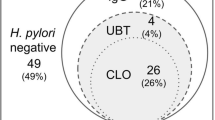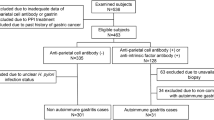Abstract
This study aimed to estimate the prevalence and type of chronic gastritis in an asymptomatic working population and to determine whether a combination of serum pepsinogen levels and Helicobacter pylori serology could be used to identify a subgroup with atrophic gastritis at elevated risk of gastric carcinoma. A 10% subsample of 544 male volunteer factory workers aged 18-63 years and participating in a larger study underwent endoscopy and biopsy. Of these men, 29 were seropositive for Helicobacter pylori; all but three (89.7%) had chronic gastritis. Serum pepsinogen A levels increased with progression from a corpus predominant pattern of gastritis through pangastritis to an antral predominant pattern. Nine subjects had corpus atrophy, which was in most cases accompanied by fasting hypochlorhydria and hypergastrinaemia. A combination of pepsinogen A below 80 ng ml-1 and Helicobaceter pylori seropositivity detected corpus atrophy with sensitivity 88.9% and specificity 92.3%. A second screening stage, using a pepsinogen A/C ratio of below 2.5 as a cut-off, resulted in a reduction in numbers requiring further investigation but with some loss of sensitivity (77.8%). Application of this two-stage screening programme to the original sample of 544 workers would have resulted in 11 (2.2%) men being selected for follow-up, excluding 25 (5.1%) false negatives. Our results suggest that a combination of serum pepsinogen levels and Helicobacter pylori serology could be useful as a biomarker strategy for detection of individuals at increased risk of gastric carcinoma and for non-invasive investigation of the natural history of Helicobacter pylori gastritis.
This is a preview of subscription content, access via your institution
Access options
Subscribe to this journal
Receive 24 print issues and online access
$259.00 per year
only $10.79 per issue
Buy this article
- Purchase on Springer Link
- Instant access to full article PDF
Prices may be subject to local taxes which are calculated during checkout
Similar content being viewed by others
Author information
Authors and Affiliations
Rights and permissions
About this article
Cite this article
Knight, T., Wyatt, J., Wilson, A. et al. Helicobacter pylori gastritis and serum pepsinogen levels in a healthy population: development of a biomarker strategy for gastric atrophy in high-risk groups. Br J Cancer 73, 819–824 (1996). https://doi.org/10.1038/bjc.1996.144
Issue Date:
DOI: https://doi.org/10.1038/bjc.1996.144
This article is cited by
-
Management of precancerous conditions and lesions in the stomach (MAPS): guideline from the European Society of Gastrointestinal Endoscopy (ESGE), European Helicobacter Study Group (EHSG), European Society of Pathology (ESP), and the Sociedade Portuguesa de Endoscopia Digestiva (SPED)
Virchows Archiv (2012)
-
The Validity of a Biomarker Method for Indirect Detection of Gastric Mucosal Atrophy Versus Standard Histopathology
Digestive Diseases and Sciences (2009)
-
Why is the hyperplastic polyp a marker for the precancerous condition of the gastric mucosa?
Virchows Archiv (2006)
-
Gastric cancer screening using the serum pepsinogen test method
Gastric Cancer (2006)
-
Biomarkers in Various Types of Atrophic Gastritis and Their Diagnostic Usefulness
Digestive Diseases and Sciences (2005)



